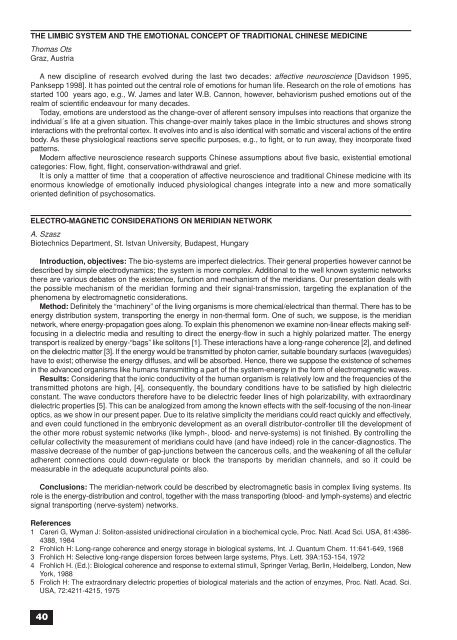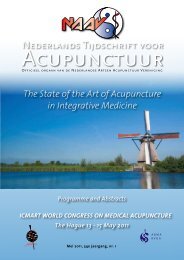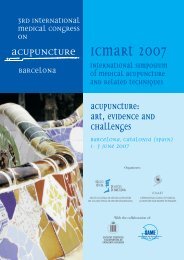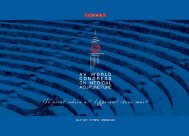Congress Abstracts full PDF - International Council of Medical ...
Congress Abstracts full PDF - International Council of Medical ...
Congress Abstracts full PDF - International Council of Medical ...
You also want an ePaper? Increase the reach of your titles
YUMPU automatically turns print PDFs into web optimized ePapers that Google loves.
THE LIMBIC SYSTEM AND THE EMOTIONAL CONCEPT OF TRADITIONAL CHINESE MEDICINE<br />
Thomas Ots<br />
Graz, Austria<br />
A new discipline <strong>of</strong> research evolved during the last two decades: affective neuroscience [Davidson 1995,<br />
Panksepp 1998]. It has pointed out the central role <strong>of</strong> emotions for human life. Research on the role <strong>of</strong> emotions has<br />
started 100 years ago, e.g., W. James and later W.B. Cannon, however, behaviorism pushed emotions out <strong>of</strong> the<br />
realm <strong>of</strong> scientific endeavour for many decades.<br />
Today, emotions are understood as the change-over <strong>of</strong> afferent sensory impulses into reactions that organize the<br />
individual´s life at a given situation. This change-over mainly takes place in the limbic structures and shows strong<br />
interactions with the prefrontal cortex. It evolves into and is also identical with somatic and visceral actions <strong>of</strong> the entire<br />
body. As these physiological reactions serve specific purposes, e.g., to fight, or to run away, they incorporate fixed<br />
patterns.<br />
Modern affective neuroscience research supports Chinese assumptions about five basic, existential emotional<br />
categories: Flow, fight, flight, conservation-withdrawal and grief.<br />
It is only a mattter <strong>of</strong> time that a cooperation <strong>of</strong> affective neuroscience and traditional Chinese medicine with its<br />
enormous knowledge <strong>of</strong> emotionally induced physiological changes integrate into a new and more somatically<br />
oriented definition <strong>of</strong> psychosomatics.<br />
ELECTRO-MAGNETIC CONSIDERATIONS ON MERIDIAN NETWORK<br />
A. Szasz<br />
Biotechnics Department, St. Istvan University, Budapest, Hungary<br />
Introduction, objectives: The bio-systems are imperfect dielectrics. Their general properties however cannot be<br />
described by simple electrodynamics; the system is more complex. Additional to the well known systemic networks<br />
there are various debates on the existence, function and mechanism <strong>of</strong> the meridians. Our presentation deals with<br />
the possible mechanism <strong>of</strong> the meridian forming and their signal-transmission, targeting the explanation <strong>of</strong> the<br />
phenomena by electromagnetic considerations.<br />
Method: Definitely the “machinery” <strong>of</strong> the living organisms is more chemical/electrical than thermal. There has to be<br />
energy distribution system, transporting the energy in non-thermal form. One <strong>of</strong> such, we suppose, is the meridian<br />
network, where energy-propagation goes along. To explain this phenomenon we examine non-linear effects making selffocusing<br />
in a dielectric media and resulting to direct the energy-flow in such a highly polarized matter. The energy<br />
transport is realized by energy-“bags” like solitons [1]. These interactions have a long-range coherence [2], and defined<br />
on the dielectric matter [3]. If the energy would be transmitted by photon carrier, suitable boundary surfaces (waveguides)<br />
have to exist; otherwise the energy diffuses, and will be absorbed. Hence, there we suppose the existence <strong>of</strong> schemes<br />
in the advanced organisms like humans transmitting a part <strong>of</strong> the system-energy in the form <strong>of</strong> electromagnetic waves.<br />
Results: Considering that the ionic conductivity <strong>of</strong> the human organism is relatively low and the frequencies <strong>of</strong> the<br />
transmitted photons are high, [4], consequently, the boundary conditions have to be satisfied by high dielectric<br />
constant. The wave conductors therefore have to be dielectric feeder lines <strong>of</strong> high polarizability, with extraordinary<br />
dielectric properties [5]. This can be analogized from among the known effects with the self-focusing <strong>of</strong> the non-linear<br />
optics, as we show in our present paper. Due to its relative simplicity the meridians could react quickly and effectively,<br />
and even could functioned in the embryonic development as an overall distributor-controller till the development <strong>of</strong><br />
the other more robust systemic networks (like lymph-, blood- and nerve-systems) is not finished. By controlling the<br />
cellular collectivity the measurement <strong>of</strong> meridians could have (and have indeed) role in the cancer-diagnostics. The<br />
massive decrease <strong>of</strong> the number <strong>of</strong> gap-junctions between the cancerous cells, and the weakening <strong>of</strong> all the cellular<br />
adherent connections could down-regulate or block the transports by meridian channels, and so it could be<br />
measurable in the adequate acupunctural points also.<br />
Conclusions: The meridian-network could be described by electromagnetic basis in complex living systems. Its<br />
role is the energy-distribution and control, together with the mass transporting (blood- and lymph-systems) and electric<br />
signal transporting (nerve-system) networks.<br />
References<br />
1 Careri G, Wyman J: Soliton-assisted unidirectional circulation in a biochemical cycle, Proc. Natl. Acad Sci. USA, 81:4386-<br />
4388, 1984<br />
2 Frohlich H: Long-range coherence and energy storage in biological systems, Int. J. Quantum Chem. 11:641-649, 1968<br />
3 Frohlich H: Selective long-range dispersion forces between large systems, Phys. Lett. 39A:153-154, 1972<br />
4 Frohlich H. (Ed.): Biological coherence and response to external stimuli, Springer Verlag, Berlin, Heidelberg, London, New<br />
York, 1988<br />
5 Frolich H: The extraordinary dielectric properties <strong>of</strong> biological materials and the action <strong>of</strong> enzymes, Proc. Natl. Acad. Sci.<br />
USA, 72:4211-4215, 1975<br />
40







